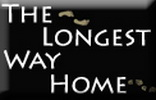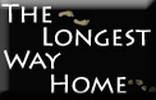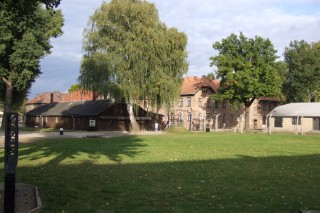 books, and seeSn the movies where it was so very often depicted. I also knew that imagination and visual stimuli were not always my preferred choice of experiencing the past. Sometimes you just have to see for yourself. Over the past few decades I'd watched the news. Rwanda, Bosnia, The Middle East the list goes on. Just why did humanity forget it's own recent history so quickly.
books, and seeSn the movies where it was so very often depicted. I also knew that imagination and visual stimuli were not always my preferred choice of experiencing the past. Sometimes you just have to see for yourself. Over the past few decades I'd watched the news. Rwanda, Bosnia, The Middle East the list goes on. Just why did humanity forget it's own recent history so quickly.
I didn't quite know what to expect physically. A local bus from Krakow takes you directly to Auschwitz itself. It's free to visit the former concentration camp. But for the first time in my travels I opted for a tour. I wanted to get as much from my visit as possible. A visitors center showed a short fifteen minute film on the history of the camp. Sitting there in the present,
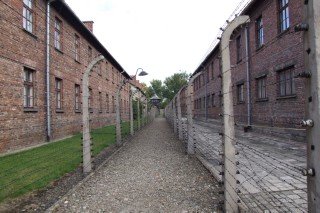 watching the past and the atrocities that occurred right were I was sitting left a daunt feeling throughout my body.
watching the past and the atrocities that occurred right were I was sitting left a daunt feeling throughout my body.
Our guide was the granddaughter of an inmate. A lady in her fifties, she spoke knowledgeably about the place. Cameras in
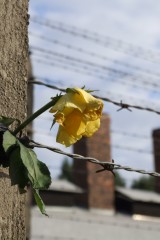 hand the large group immediately began photographing the entrance way into the camp. My own mind tried to imagine what it must have been like to be brought to such a place as a prisoner. It was difficult to accomplish. A lone yellow flower placed into a barb wire fence told me that others knew.
hand the large group immediately began photographing the entrance way into the camp. My own mind tried to imagine what it must have been like to be brought to such a place as a prisoner. It was difficult to accomplish. A lone yellow flower placed into a barb wire fence told me that others knew.
Inside the camp what struck me the most were the stone buildings, barbed wire and warning signs. The
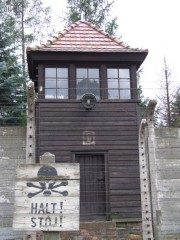 signs were for the prisoners and not the tourists. It could have been only a few months before hand that the prison had been occupied. We entered a select number of three story barracks where both the Nazi's and prisoners were housed. Maps, desks, and offices lined the Nazi sections. Efficiently and set up like any pre digital business would have been. In the prisoner sections were various collections. Photographs, stories, lists, birth and death dates. There were other rooms too. More chilling ones. Rooms that showed all the shoes collected from a certain
signs were for the prisoners and not the tourists. It could have been only a few months before hand that the prison had been occupied. We entered a select number of three story barracks where both the Nazi's and prisoners were housed. Maps, desks, and offices lined the Nazi sections. Efficiently and set up like any pre digital business would have been. In the prisoner sections were various collections. Photographs, stories, lists, birth and death dates. There were other rooms too. More chilling ones. Rooms that showed all the shoes collected from a certain
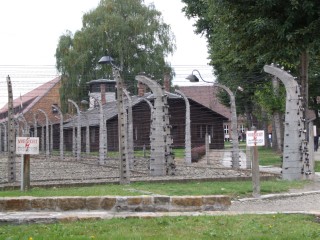 batch. Teeth and fillings still in lay in boxes waiting to be shipped somewhere else. In another room all the suitcases collected stacked high behind a glass partition. A story for each one; as many thought they were going somewhere else. Our guide told a few true life tales of woe making it all so very real. Worse still was when we entered a room piled high with human hair. Everything was utilized. Everything.
batch. Teeth and fillings still in lay in boxes waiting to be shipped somewhere else. In another room all the suitcases collected stacked high behind a glass partition. A story for each one; as many thought they were going somewhere else. Our guide told a few true life tales of woe making it all so very real. Worse still was when we entered a room piled high with human hair. Everything was utilized. Everything.
Outside we then did what so many tourists want. We visited a gas chamber. The
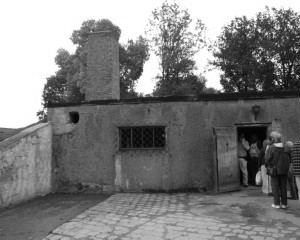 Nazi's had destroyed most of chambers before deserting the camp at the end of world war two. And in actual fact nearby Birkenau was where most of the killing took place. The chamber itself was more like a concrete underground bunker. Small and compact. Single small doors leading in and out. The main chamber was like the documentaries. Big, bare, and with various openings in the roof for the pellets to be dropped. Beside it, another room with several large furnaces. I made a conscious decision not to photograph inside these places. There's plenty of media coverage out there. For me it was about remembrance, and feeling.
Nazi's had destroyed most of chambers before deserting the camp at the end of world war two. And in actual fact nearby Birkenau was where most of the killing took place. The chamber itself was more like a concrete underground bunker. Small and compact. Single small doors leading in and out. The main chamber was like the documentaries. Big, bare, and with various openings in the roof for the pellets to be dropped. Beside it, another room with several large furnaces. I made a conscious decision not to photograph inside these places. There's plenty of media coverage out there. For me it was about remembrance, and feeling.
Birkenau was perhaps even more chilling to me due to its massive
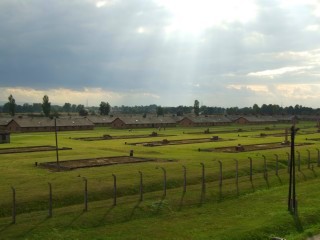 scale. From the roadside it looked just like a small village train station. But once inside it's large gates you see panning out before you two sections of green field upon green field containing old wooden barracks. Now, the true horrific scale of it all becomes apparent. To the left, the women's section was well preserved. To the right the men's section had only two rows of reconstructed prison barracks left. Behind them lay rows of chimney stacks and foundation outlines of other buildings. That sight was enough to put anyone in their place.
scale. From the roadside it looked just like a small village train station. But once inside it's large gates you see panning out before you two sections of green field upon green field containing old wooden barracks. Now, the true horrific scale of it all becomes apparent. To the left, the women's section was well preserved. To the right the men's section had only two rows of reconstructed prison barracks left. Behind them lay rows of chimney stacks and foundation outlines of other buildings. That sight was enough to put anyone in their place.
Inside the barracks the accommodation was not as the war movies
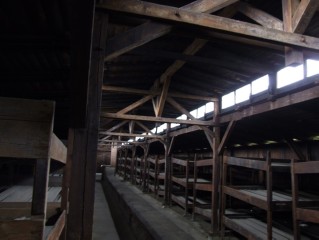 made out. The wooden sleeping bunks were huge and very cramped. Three or four to a bed. The toilets were concrete potty holes in the ground where each prisoner had a maximum time of thirty seconds. Considering the the first two meals of a day were watered down coffee grounds and gruel it wasn't very necessary to stay long. Later hard stale bread was added, for some. The process was after all; not for survival.
made out. The wooden sleeping bunks were huge and very cramped. Three or four to a bed. The toilets were concrete potty holes in the ground where each prisoner had a maximum time of thirty seconds. Considering the the first two meals of a day were watered down coffee grounds and gruel it wasn't very necessary to stay long. Later hard stale bread was added, for some. The process was after all; not for survival.
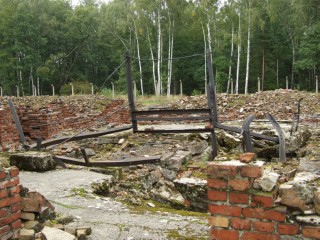 Our tour guide finished up by taking us to the huge gas chambers behind the barracks. Here there was little to see but rubble. Again in their desperate attempts to cover up the what went on in the camps, the Nazi's blew the gas chambers up before leaving. I'd known about this before. But standing there was something else. Chimney stacks, furnaces and chambers all torn apart in rubble strewn areas. It was
Our tour guide finished up by taking us to the huge gas chambers behind the barracks. Here there was little to see but rubble. Again in their desperate attempts to cover up the what went on in the camps, the Nazi's blew the gas chambers up before leaving. I'd known about this before. But standing there was something else. Chimney stacks, furnaces and chambers all torn apart in rubble strewn areas. It was
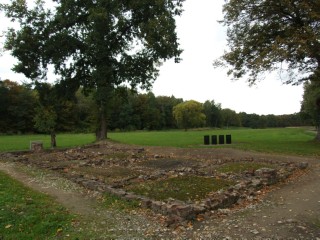 so blatant. And I wonder why they even bothered.
so blatant. And I wonder why they even bothered.
The tour over I separated from the group and walked past the memorials, the former chambers and then past the huge containers where human ash was stored. Least we forget, everything, was recycled here. It
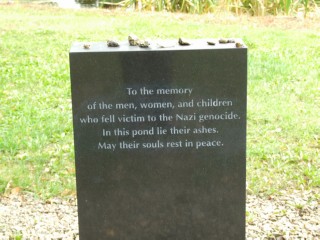 was in the fields behind that I came across even more tragic reminders. A field with several black marble memorials written in different languages stood. It was here where the over flow of human ash was dumped. The containers too full to handle the by product of human destruction. Then, further along, a quaint pretty pond. Another dumping ground for human ash. Through the forested areas around the camp were
was in the fields behind that I came across even more tragic reminders. A field with several black marble memorials written in different languages stood. It was here where the over flow of human ash was dumped. The containers too full to handle the by product of human destruction. Then, further along, a quaint pretty pond. Another dumping ground for human ash. Through the forested areas around the camp were
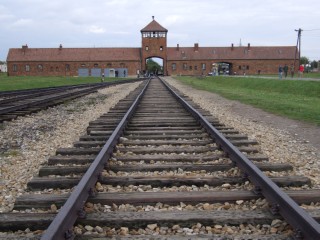 nailed up photographs of those forced to clean and tend the area. Old faces from the past, long gone; one way or another.
nailed up photographs of those forced to clean and tend the area. Old faces from the past, long gone; one way or another.
I then circled round to the start of the entrance of the camp. Over the train tracks where thousands of prisoners were brought to their fates. The red stoned building from Spielberg's Schindler's list looked nothing like a movie now. This was real; memories from humanities history had not been forgotten. But have been consciously ignored. At least from what I can tell. I fear should such a war ever break out again the atrocities would be a lot worse now. The impact engrossing and effecting a new generation; least we ... think of the future.
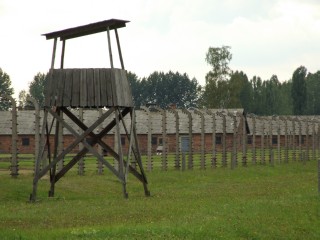
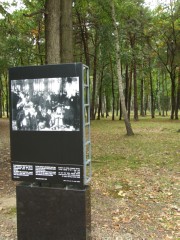
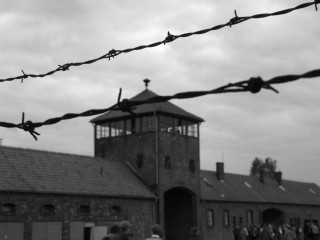
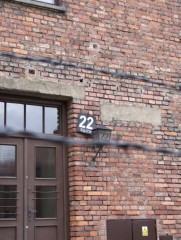
|
|---|
